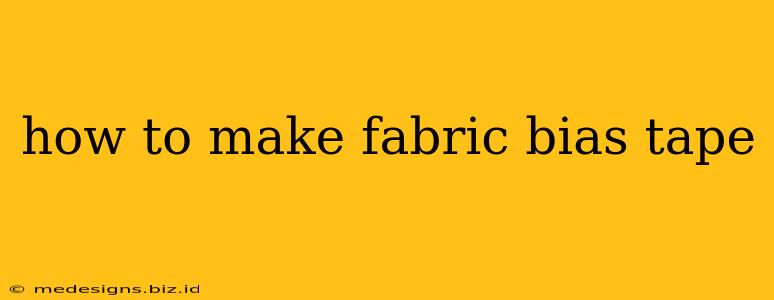Making your own fabric bias tape is surprisingly easy and offers a professional finish to your sewing projects. It's far more economical than buying pre-made tape, especially if you're working on a large project or using unique fabrics. This comprehensive guide will walk you through the process, from selecting your fabric to creating perfectly pressed bias tape.
Choosing Your Fabric and Tools
Before you begin, gather your materials. The type of fabric you choose will greatly influence the final look and feel of your bias tape. Consider the project you're working on. A sturdy cotton works well for most applications, while silk or linen creates a more luxurious finish.
You'll need:
- Fabric: Choose a fabric that complements your project. A fat quarter is usually sufficient, depending on the width of your desired tape.
- Rotary cutter and mat (optional but highly recommended): These tools make cutting long, straight lines much faster and more accurate.
- Iron and ironing board: Essential for creating crisp, professional-looking bias tape.
- Scissors or pinking shears: Pinking shears help prevent fraying.
- Ruler: A clear ruler aids in accurate measurements.
- Sewing machine (optional): While you can hand-sew bias tape, a sewing machine significantly speeds up the process.
- Pins: For holding fabric pieces together.
Cutting Your Fabric Bias
This is the most crucial step. Bias refers to cutting your fabric at a 45-degree angle to the selvedge (the finished edge of the fabric). Cutting on the bias provides flexibility and prevents the tape from stretching unevenly.
Instructions:
- Determine Your Desired Tape Width: Decide how wide you want your finished bias tape. Remember, the final width will be smaller than your cut strips. A common width is 1/2 inch (1.25 cm). Add seam allowances to your desired width; 7/8 inch (2.2 cm) is good starting point for a 1/2 inch tape.
- Cut Fabric Strips: Cut your fabric into strips along the bias. The longer the strips, the less seaming you'll need later. Aim for strips at least 45 inches long, even longer if your sewing machine allows for that much fabric feed.
- Press the Strips: Press each strip in half lengthwise, wrong sides together, then open it back up. This creates a center crease that will be helpful during the next steps.
Sewing and Pressing Your Bias Tape
Now it's time to transform your bias strips into perfectly formed tape. This step can be done either by hand or with a sewing machine.
Sewing Machine Method:
- Fold and Press: Fold the raw edges of the pressed strip into the center crease. Press firmly.
- Sew the Edges: Stitch close to the folded edge, using a 1/8 inch seam allowance.
- Press Again: Press the seam allowance open.
- Fold and Press: Fold the tape in half lengthwise again, with the seam in the center. Press firmly. Your bias tape is ready to use!
Hand-Sewing Method:
- Fold and Press: Follow steps 1 and 2 of the sewing machine method.
- Fold and Stitch: Fold the tape in half lengthwise, then hand stitch the edges together, creating a closed seam.
- Press: Press firmly to create a clean finish.
Using Your Homemade Bias Tape
Once your bias tape is made, you can use it to bind seams, edges, or create decorative accents on your sewing projects. Remember to use pins to secure the tape in place before sewing it down.
Tips for Success
- Use sharp scissors or a rotary cutter: This ensures clean, accurate cuts.
- Press diligently: Proper pressing is key to creating a professional-looking finish.
- Experiment with different fabrics: Explore various fabrics to achieve different textures and looks.
- Don't be afraid to make mistakes: Practice makes perfect!
Making your own bias tape is a valuable skill for any sewer. It's cost-effective, allows for creative control, and enhances the overall quality of your projects. So grab your fabric and start creating!
